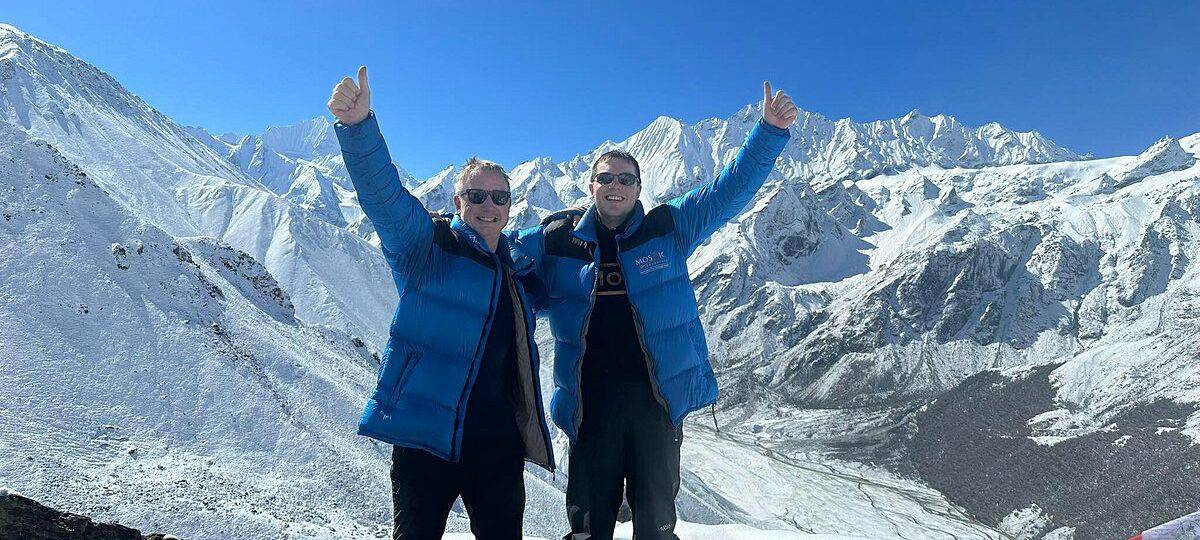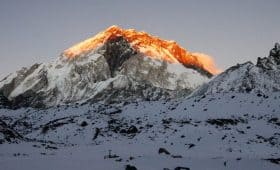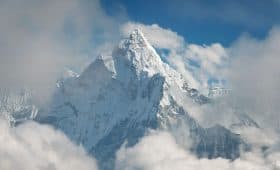Everest Base Camp trek is one of the most famous, legendary and magnificent trekking route in the world that centers on the tallest snowy peak Mt. Everest (8,848.86 meters).
Everest Base Camp for beginners or those with extensive experience trekking various routes around the world, it won’t disappoint and will equally satisfy them all.
Commonly known as ‘steps to heaven’, trekking experience on this wonderful route takes you on the path accompanied by the magnificent mountain peaks of the Himalayas passing through different landscapes, beautiful high Himalayan Sherpa civilizations, popular and religious landmarks like Tyangobhce Monastery and of course the well dreamed destination – base camp of the highest mountain in the world.

Popular among all trekking enthusiast either they are experienced or beginners, our specially tailored package makes sure that you will have a fulfilling and rewarding experiences trekking to the base of the highest Himalayan peak.
With the right amount of preparation, this once-in-lifetime experience is an achievable dream that everyone can dream and fulfill.
Read | Everest Base Camp Cost
Table of Contents
- Itinerary of Everest Base Camp for Beginners
- Day 1: Airport pick-up and hotel transfer
- Day 2: Kathmandu to Lukla flight and trek to Phakding
- Day 3: Phakding to Namche Bazaar
- Day 4: Acclimatization day (Hike to Everest View Hotel and Khumjung Village)
- Day 5: Trekking to Tengboche
- Day 6: Tengboche to Dingboche trekking
- Day 7: Acclimatization day at Dingboche
- Day 8: Uphill trekking to Lobuche
- Day 9: Trekking up to Everest Base Camp and trek back to Gorak Shep
- Day 10: Early morning hike to Kalapatthar and trek to Pheriche
- Day 11: Retracing steps back to Namche Bazaar
- Day 12: Downhill trek to Lukla
- Day 13: Lukla to Kathmandu flight
- Day 14: Departure Day
- Best Season for Everest Base Camp Trek
- Everest Base Camp Trek Difficulty
- Challenges Faced By Beginners On A Trek
- Everest Base Camp for Beginners- Preparation Guideline
- FAQs Related to Everest Base Camp for Beginners
- Can a beginner go to Everest Base Camp?
- Can a normal person climb Everest base camp?
- Can you do Everest Base Camp with no training?
- How a beginners practice for the hike to Everest Base Camp?
- Is reaching Everest Base Camp difficult?
- How fit do you need to be to get to Everest Base Camp?
- Can anyone go to Everest Base Camp?
- As a beginner for EBC, can I customize the itinerary to make it easier for me?
- Some Helpful Tips of Everest Base Camp Trek for Beginners
- Summary
Itinerary of Everest Base Camp for Beginners
Following 14-day Everest Base Camp Trek itinerary is suitable for both beginners and experienced trekker.
Below proposed itinerary caters to both novice and seasoned trekkers by allowing ample time for acclimatization and a gradual approach to our final destination.
With an ascent from 2,860 meters (9,383 feet) at Lukla to 5,545 meters (18,192 feet) at Kalapatthar, proper acclimatization becomes the crucial and central factor essential for successfully completing the EBC trek.
Avoid unnecessary risks; choose an itinerary that includes two acclimatization days.
Our journey spans 8 days to reach the EBC, followed by a swift descent in just 3 days. This strategic plan ensures your body can adeptly acclimate to the daily altitude increments along this challenging trail.
Day 1: Airport pick-up and hotel transfer
Kathmandu Elevation: 1,345 meters
Duration: 15-25 drive to the hotel from TIA
After arriving at the TIA (Tribhuvan International Airport) proceed toward the terminal, claim your baggage, get your on arrival Nepal visa and as you exit the airport you will meet our staff with Mosaic Adventure sign.
Our team member will drop you to your hotel and help with check-in procedures.
You can get refreshed and rest for a bit or set out on the exploration of the bustling capital city sampling the local eateries and check-in out the major tourist highlights.
You can also use this time to check out trekking equipment and clothing, there is also an arrangement for renting in Kathmandu. In the evening your guide will meet with you and give you a brief description of the journey up ahead.
Accommodation: Three-star hotel in Kathmandu.
Day 2: Kathmandu to Lukla flight and trek to Phakding
Kathmandu Elevation: 1,345 meters
Lukla Elevation: 2,840 meters
Phakding Elevation: 2,610
Elevation Gain (Kathmandu to Lukla): 1,495 meters
Elevation Loss(Lukla to Phakding): 230 meters
Duration: 25-30 minutes flight and 3.5 hours of trekking
On the second day of your arrival, your Everest Base Camp foe beginner expedition will truly begin. After a 25-30 minutes cross-valley flight enjoying the scenic beauty of green flat valleys below and moving across the hills towards the gateway of the Himalayas you will land on Lukla.
This flight is followed by 4 hours drive to Ramechap during peak season and about 20 minutes drive to Kathmandu airport in off season. You will meet the rest of the trekking team here and start your journey toward Phakding.
As it is mostly downhill trekking today, it will be an easy walk; walking alongside the Dudh Koshi Rivet passing through several beautiful Sherpa civilizations and cross the suspension bridge heading toward Phakding.
The beautiful Phakding Village is a popular overnight stay destination en route to the Everest expeditions.
Accommodation: Tea house lodging
Day 3: Phakding to Namche Bazaar
Phakding Elevation: 2,610
Namche Bazaar Elevation: 3,440 meters
Elevation Gain (Phakding to Namche Bazaar): 830 meters
Duration: 6 hours
On this day of trekking, you will gain walk along the soaring Dudh Koshi River heading towards north and after crossing the Hillary Suspension Bridge, you will leave the beautiful Phakding Valley behind.
Then shortly, your trail will follow the route of the Bhote Koshi River, as sister river of the Dudh Koshi River, high-Himalayan civilizations like Chimayo, Benkar, Monjo, and Josale and spiritual route decorated with Buddhist praying flags and Chortens will be the major highlight of today’s trek.
Passing along the rhododendron, magnolia, and pine forest, you will hike a steep hill during the last stretch that will open up the wider clear vistas to the incredible massifs like Mt. Everest, Mt. Lhotse, Mt. Nuptse, and Kongde Peaks.
Accommodation: Tea house lodging

Day 4: Acclimatization day (Hike to Everest View Hotel and Khumjung Village)
Namche Bazaar Elevation: 3,440 meters
Everest View Hote Elevation: 3,962 meters
Khumjung Village Elevation: 3,790 meters
Elevation Gain (Namche Bazaar to Everest View Hotel): 522 meters
Elevation Gain (Namche Bazaar to Khumjung Village): 350 meters
Duration: 4 hours
On the fourth day of our Everest Base Camp for beginners and experienced trekker, you will rest and adapt to the high-altitude environment. As the trekking has reached a significant elevation jump point of over 3,000 meters, it is important to acclimatize to the sudden exposure to the high-altitude environment.
If you are feeling fine, you could use this day to hike up to Khumjung Village and Everest View Hotel, these are some of the popular activities during the acclimatization day in Namche Bazaar.
Or, just stroll around the trading hub of the Khumbu region checking out popular tourist destinations like Hilary School, Sagarmatha National Park Museum, Sherpa Museum, the world’s highest Irish Pub, and Khumjung Monastery.
Accommodation: Tea house lodging
Day 5: Trekking to Tengboche
Namche Bazaar Elevation: 3,440 meters
Tengboche Elevation: 3860 meters
Elevation Gain (Namche Bazaar to Tengboche): 420 meters
Duration: 5 hours
It’s a beautiful day trek up ahead today, trekking along the Dudh Koshi River, you will traverse across the thick forests with rhododendron and juni[er trees.
The unobstructed clear views of the Himalayan peaks like Mt. Everest, Mt. Lhotse, Mt Nuptse, and Mt. Ama Dablam will accompany you on today’s trek.
You will gradually leave the greenery behind and walk across a narrow steep line that will open the wider vistas as you reach the Tengboche Village.
Tengboche Monastery, one of the oldest and most significant pillars of the Buddhist religion fills the whole region with its spiritual vibe. If you are eager to learn more, visitors are allowed to witness the prayers ‘puja’ that starts around 3 p.m.
Accommodation: Tea house lodging
Day 6: Tengboche to Dingboche trekking
Tengboche Elevation: 3860 meters
Dingboche Elevation: 4,360 meters
Elevation Gain (Tengboche to Dingboche): 500 meters
Duration: 5 hours
Today we will explore the heart of the Khumbu region. Walking alongside the Imja Khola, you will come across several suspension bridges and head toward the Imja Valley.
After ascending uphill to Somare, you will reach a junction point that separates Dingboche and Pheriche.
Today’s trek will pass through Pagboche, the last permanent village in the Khumbu region en route to the Everest expedition, the sacred Mani Walls, and several Buddhist monasteries and chortens.
The magnificent Ama Dablam feels closer in today’s trek and of course, other massifs like Mt. Nuptse, Mt Cholastse, and several others will be in the background to brighten the trail as you enter Dinboche aka summer valley.
Accommodation: Tea house lodging
Day 7: Acclimatization day at Dingboche
Dingboche Elevation: 4,360 meters
After ascending over 500 meters, today will be your 2nd acclimatization day; you will rest here today and explore the region if you feel like doing any physical activity.
You can hike up to Nagarjun Hill from where you can enjoy the panoramic views of gems of the Himalayas like Mt. Ama Dablam, Mt. Lobuche, Thamserku, and Taboche Peak.
If you still didn’t have your fill of adventure on this day, trek up to the Nagkarshang Peak (5,083 meters) at the end of Chhukung Valley or just take a break admiring the culture, traditions, and lifestyle of the beautiful high-Himalayan valley.
Accommodation: Tea house lodging
Day 8: Uphill trekking to Lobuche
Dingboche Elevation: 4,360 meters
Lobuche Elevation: 4,940meters
Elevation Gain (Dingboche to Lobuche): 580 meters
Duration: 5 hours
The adventure on the 8th of the Everest Base Camp expedition can be moderately difficult as it involves ascending through steep segments.
Moving along the steep moraine of the Khumbu Glacier you will traverse across the rocky terrains and yak pasture towards Dughla, a small town with few tea houses.
Then, you will move towards the Thukla Pass, also known as the ‘Everest Memorial Ground’ which is dedicated to lives lost on Mt. Everest.
The trail along the pass gets relatively leveled after a climb during the last stretch as you head toward the Lobuche Village.
You will enjoy the immersive views of beautiful peaks like Mt. Ama Dablam, Mt. Nuptse, Mt. Pumori, and Mt. Tawache on today’s trek and they will be also in the background at your resting destination today.
Accommodation: Tea house lodging
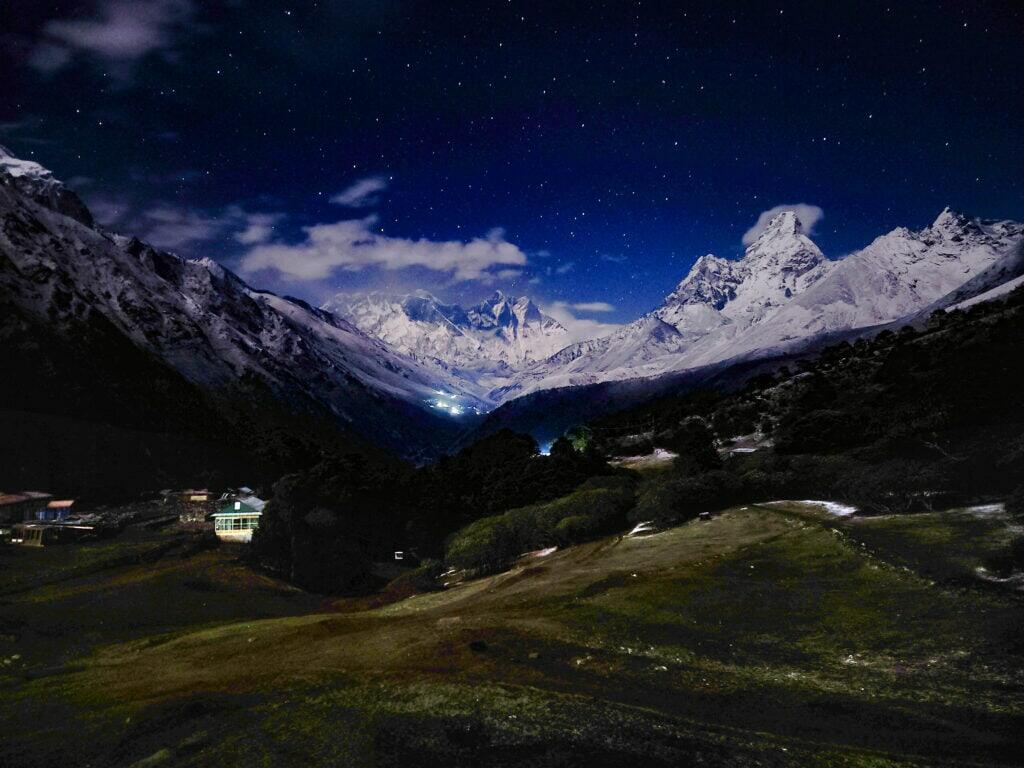
Day 9: Trekking up to Everest Base Camp and trek back to Gorak Shep
Lobuche Elevation: 4,940meters
Everest Base Camp Elevation: 5,364 meters
Gorak Shep Elevation: 5,170 meters
Elevation Gain (Lobuche to Everest Base Camp): 424 meters
Elevation Loss (Everest Base Camp to Gorak Shep): 194 meters
Duration: 8 hours
Finally, the big day has arrived, today you will conquer this quest and declare your victory at the foothills of the glorious and highest peak in the world, Mt. Everest. In the first half of this trek, you will hike up to Gorak Shep and after a short rest you will keep pushing for the foothills of Everest.
The steep segments, rock terrains, and glacial traverse of the Khumbu ridge can be slightly difficult in today’s trek but the determination to reach the Everest Base Camp having come up so close will make it seem like an effortless walk.
From the Everest Base Camp, besides the views of the magnificent- tallest mountain in the world, you will also get to immerse in the beauty of other Himalayan peaks like Mt Pumori, Mt. Chagtse, and Mt. Nuptse including Khumbu Glacier.
After enjoying the victory and the unprecedented beauty in the laps of the mountain you will trek back to Gorak Shep for an overnight stay.
Accommodation: Tea house lodging
Day 10: Early morning hike to Kalapatthar and trek to Pheriche
Gorak Shep Elevation: 5,170 meters
Kalapatthar Elevation: 5,545 meters
Pheriche Elevation: 4,270 meters
Elevation Gain (Gorak Shep to Kalapatthar): 375 meters
Elevation Loss (Kalapatthar to Pheriche): 1,275 meters
Duration: 7 hours
The adventure in the Khumbu Region is an incomplete journey without exploring the Kalapatthar. So, today, you will start your trek early in the morning and head towards the highest elevation point of this trek, Kalaptthr for an early sunrise view.
From this vantage point, you will be able to enjoy the spectacular sunrise view of the sun immersing from the gap of the mountain and of course, the 360° panoramic view of the world-renowned mountain ranges like Mt. Everest, Mt. Lhotse, Mt. Changtse, Mt Nuptse and Mt. Pumori.
Then after, soaking in the beauty of the Himalayas, you will trek down to Pheriche, you will rest here tonight enjoying the warm delicacies and going through the memory lanes of this amazing adventure.
Accommodation: Tea house lodging
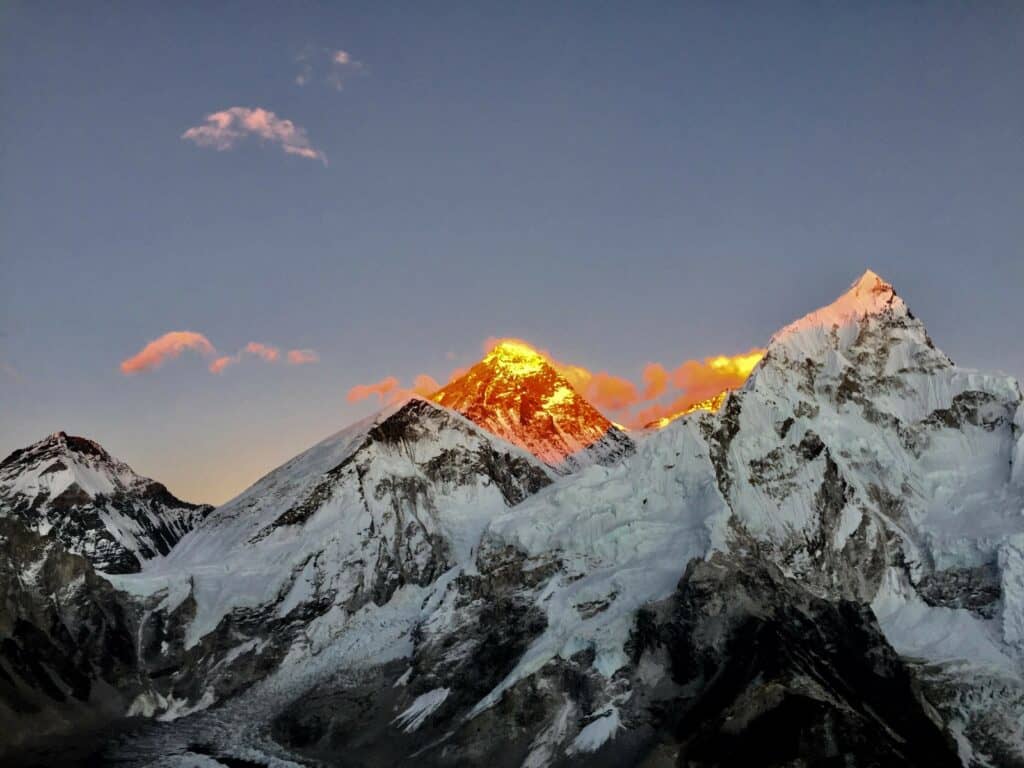
Day 11: Retracing steps back to Namche Bazaar
Pheriche Elevation: 4,270 meters
Namche Bazaar Elevation: 3,440 meters
Elevation Loss (Pheriche to Namche Bazaar): 830 meters
Duration: 7 hours
After concluding the Everest Base Camp for beginners, in today’s trek, you will retrace your steps back to Namche Bazaar.
Although it’s a downward trek there are still some uphill segments as you head towards the Sherpa capital. After crossing Pangboche Village you will trek alongside the Imja Khola and climb to Tyangboche, after immersing in the spiritual vibe of the Tyangboche Monastery one last time you will walk towards Namche Bazaar.
The greenery will return in today’s trek as you leave the wide vistas of the Himalayas behind as you reach the trading hub of the Khumbu Region.
This will be like your first day back in a modern town as you can enjoy all the urban services and extensive eatery menus.
Accommodation: Tea house lodging
Day 12: Downhill trek to Lukla
Namche Bazaar Elevation: 3,440 meters
Lukla Elevation: 2,840 meters
Elevation Loss (Namche Bazaar to Lukla): 600 meters
Duration:
On the last day of your Khumbu journey, you will walk down to Lukla, where it all began.
Enjoying the same scenic beauty of the Himalayan region but slightly from a different prospect, you will trek across the lush rhododendron, magnolia and pine forest alongside the Bhote Koshi River and pass several Sherpa civilizations.
After climbing for about 45 minutes during the last segment of the trek, you will reach Lukla. You will stay here tonight at the teahouse and have the Himalayas so up-close in the background for the last time of this expedition.
Accommodation: Tea house lodging
Day 13: Lukla to Kathmandu flight
Lukla Elevation: 2,840 meters
Kathmandu Elevation:1,345 meters
Elevation Loss (Lukla to Kathmandu): 1,495 meters
Duration: 25-30 minutes flight
The time to bid farewell to the Khumbu Region has come, you will board a morning flight to Kathmandu from Lukla.
Enjoying the immersive cross-valley flight, you will leave the Himalayan region moving towards the bustling and vibrant capital.
After resting for a bit, you can stroll around the city during the day and collect souvenirs or you trip back home.
Accommodation: Three-star hotel in Kathmandu.
Day 14: Departure Day
Concluding your Lukla to Everest Base Camp journey, it’s time for your departure. Our team member will pick you up from your hotel and take you to TIA as per your flight schedule.
Have a safe journey; we hope to see you again!!
Want more information? Send us your query, and our experts will get back to you within 24 hrs.
Best Season for Everest Base Camp Trek
The best season for the Everest Base Camp trek like any other trekking adventure in the country is spring (March to May) and autumn (September to November).
Both of these seasons are peak trekking seasons in Nepal and hundreds of trekkers and mountaineers set out on the exploration of the popular trekking routes in the country.
Spring and autumn is recommended season to trek to Everest Base Camp for beginner as mild temperature and clean weather really helps you adapt to the high altitude area.
During the spring season, the Himalayan region is blooming with life, the trails will be decorated with beautiful seasonal flowers, rhododendrons, in particular, fill the lower trails with their alluring beauty.
It is also the best season to view the endangered species of flora and fauna in the Sagarmatha National Park. Although the occasional snowfall during spring can make night cold, the weather is normally stable warm, and clear.
The temperature of the Khumbu region stays at 17° C during the daytime and can drop up to -8° C at night and early mornings.
Similarly, autumn, the post-monsoon season is another peak time for adventures in the Everest region.
Although the nights and mornings are colder in the autumn, the clear vistas, the fresh terrain washed up by the monsoon rain and the stable weather make it the best time for outdoor adventure.
The latter month of the season may start seeing light rainfall at the end of November so special preparation is required if you are traveling close to the winter.
Normally, the temperature is stable and stays around 14°C on average during autumn, the chillier nights can drop up to -10°C. It is also possible for Everest Base Camp to trek during the off-seasons like monsoon (June- August) and winter (December to February).
The cold harsh weather and snowfall during the winter (temperature fluctuates around –20°C to 0°C) that often cover the trail and the muddy slippery terrain with the risk of landslides during monsoon (17°C to -15°C) might not be the best choice for a trekking beginner.
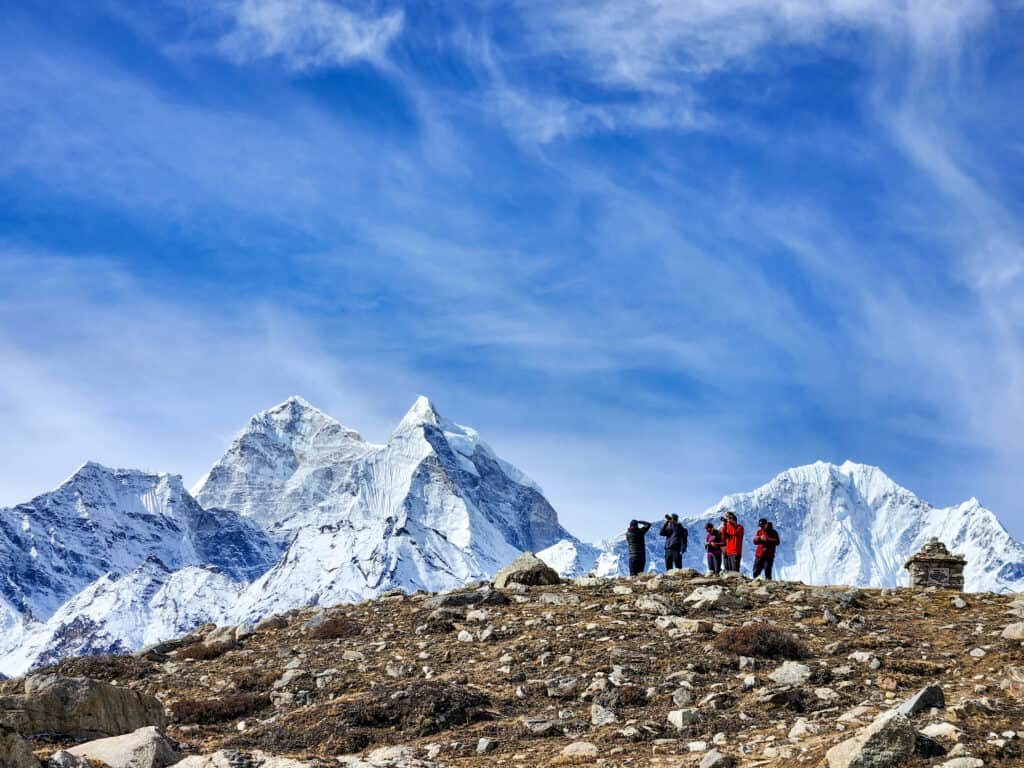
Everest Base Camp Trek Difficulty
Everest Base Camp trekking has been graded as moderately difficult, as it involves steep ascends and descends that last little less than two weeks.
One of the major concerns for new beginners can be the altitude gain in this expedition, AMS (Acute Mountain Sickness) has always been a nightmare for trekking enthusiasts who love high-altitude adventure. In elevation points above 5,500 meters, only 50% of oxygen is present in the air, so the high-altitude adventure isn’t like backyard walking.
But, it doesn’t mean that altitude sickness is invincible, in order to deal with the high altitude jump during the trek, the packages have been designed to provide proper acclimation days so the body can get used to the high altitude environment.
You can also communicate with the health personnel of the trekking team if you are facing any kind of difficulties. With the right preparation and right care, the Everest Base Camp trekking isn’t a big challenge.
In fact, the success rate for the EBC trekking is approximately 95% to 97% and in the past, even children and trekkers above 70+ age have successfully completed the trek.
Along with challenging terrain, for some Everest Base Camp Trek accommodation can also make it bit difficult as they are not used to such basic teahouse lodges.
Always have lower expectations when you sign up for this trek, expect teahouses to be better than tents but nothing fancy.
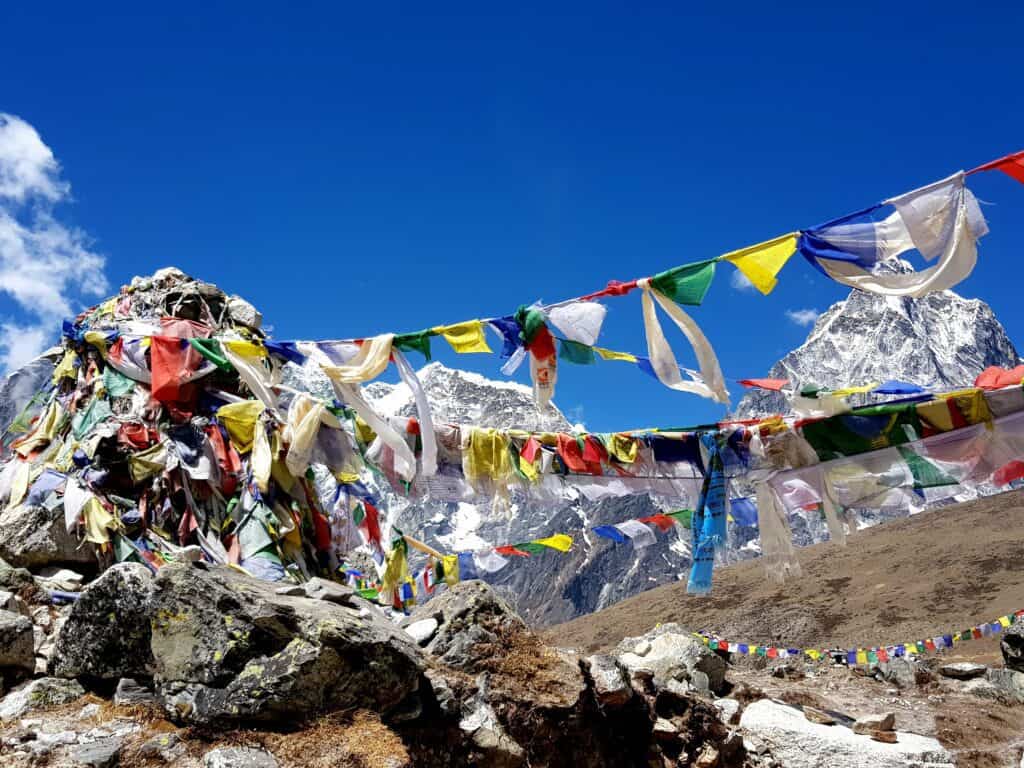
Challenges Faced By Beginners On A Trek
Starting a trek as a beginner is both fun and hard. But there are some usual problems that beginners might have during a trek:
Even though these challenges can be tough, facing them can make the trek enjoyable and change how you see things.
If beginners get ready well, have some guidance, and stay positive, they can beat these challenges and really have a great time enjoying the beauty and adventure of trekking.
Physical Endurance
If you’re new to trekking, remember that being physically fit is really important. Trekking can be tough, with long walks, uphill climbs, and walking on uneven ground.
So, it’s important to slowly get your body used to these challenges by building up your strength and stamina over time.
Altitude Sickness
When you go on high-altitude treks, remember that beginners might feel altitude sickness. It can make you have bad symptoms like bad headaches, feeling sick, being dizzy, and very tired.
So, it’s really important to give yourself enough time to get used to the high altitude before you go too fast or do too much.
If you take it slow and let your body get used to the high place slowly, you can lower the chance of getting sick and make the symptoms less severe. This way, you can fully enjoy your trek without any problems.
Unknown Terrain
Trekking is a fun outdoor activity where you walk in different and sometimes tough places, like rocky paths, steep climbs that challenge your strength, and weather that might be hard to deal with.
For people who are just starting, this might seem a bit scary, and they might need help from experts to walk through these different places with confidence and not find it too hard.
Packing Challenges
Planning for a trip can be hard, especially when deciding what to pack and how to pack it efficiently. People who are new to traveling might put too many things in their bags, making them heavy and inconvenient.
On the other hand, they might need to pack more, forgetting important stuff. Finding the right balance between comfort and practicality takes time and practice.
Coping with Weather Conditions
When you’re getting ready for a trip to the mountains, remember that the weather can change a lot and be a bit hard to predict.
Especially if you’re new to adventures, make sure you’re ready for quick and big shifts in temperature, rain, or snow.
Dealing with these tough and always-changing conditions can be a big challenge. You’ll need to be tough and able to adapt to stay comfy and safe.
Finding Your Way
If you’re new to hiking or trekking, understanding trail markers, reading maps, and figuring out route directions might seem a bit too much. Beginners often feel lost or confused because they have yet to do much navigating. So, it’s important to work on these skills to make sure your time outdoors is safe and fun.
Accommodation and Hygiene
Beginners in trekking may need some help adjusting to shared living spaces, basic amenities, and simple hygiene facilities provided in accommodations during the trek.
Social Challenges
When you join a guided trekking tour, it’s important to be ready for how the group works together. That might be tough, especially if you’re new to it.
You’ll meet different types of people, communicate in different ways, and share things with the group. Whether you’re walking in tough areas or camping outside, it’s crucial to think about these things to have a good and successful journey.
If you learn how to handle the challenges of being in a trekking group, you can really enjoy the experience and make strong connections with your fellow adventurers.
Emotional Resilience
Taking part in physically demanding activities and dealing with unpredictable situations can deeply affect how a person feels. Especially for those who are new to these kinds of experiences, they might sometimes feel unsure about themselves, scared, or frustrated.
In order to effectively manage difficult emotions and overcome challenges, it is crucial to develop emotional resilience. It means learning to adjust to tough situations, handle stress, and stay positive even when things get hard.
Environmental Responsibility
Going on a trek is an exciting way to discover nature, but it comes with some important things to remember. If you’re new to trekking, it might be hard to understand and do responsible trekking.
That means doing things like not leaving any garbage behind, respecting the local customs and beliefs, and being careful not to make the environment dirty.
If people follow these rules, they can have a good time while also making sure nature stays beautiful for the next people who come.
Everest Base Camp for Beginners- Preparation Guideline
The success rate of the Everest Base Camp trek depends on how much time you put in for the preparation.
If you are planning just wing it with a few days of preparation, then it is certainly going to be a challenge to complete, as the body starts to get weary at higher altitudes with low oxygen saturation levels.
As the everest base camp height is 17,598 ft or 5,364 metres. It is recommended that you should at least start training your body 8 to 12 weeks prior to the expedition.
It will be even better if you can practice hiking on natural terrain carrying your backpack with considerable weight.
You don’t have to put in tons of effort if you are already used to doing exercise or physical activities, but it is very essential to build endurance and stamina for the trek.
Try to cover at least 4-7 km of jogging or hiking during the preparation period and use the stairs training method as well, this will get you used to climbing and descending sections during the trek.
You don’t need to be ripped or a heavyweight for this adventure, all you have to be mindful of during the adventure is basically two things, your stamina for an average of 6-7 hours of walking and strength as you have to carry your backpack as well bear with heavy clothing and footwear.
Practicing hiking in your hiking boots will certainly come in handy too, you will be able to break in and check the comfort level of your boots to avoid any inconveniences during the trek.
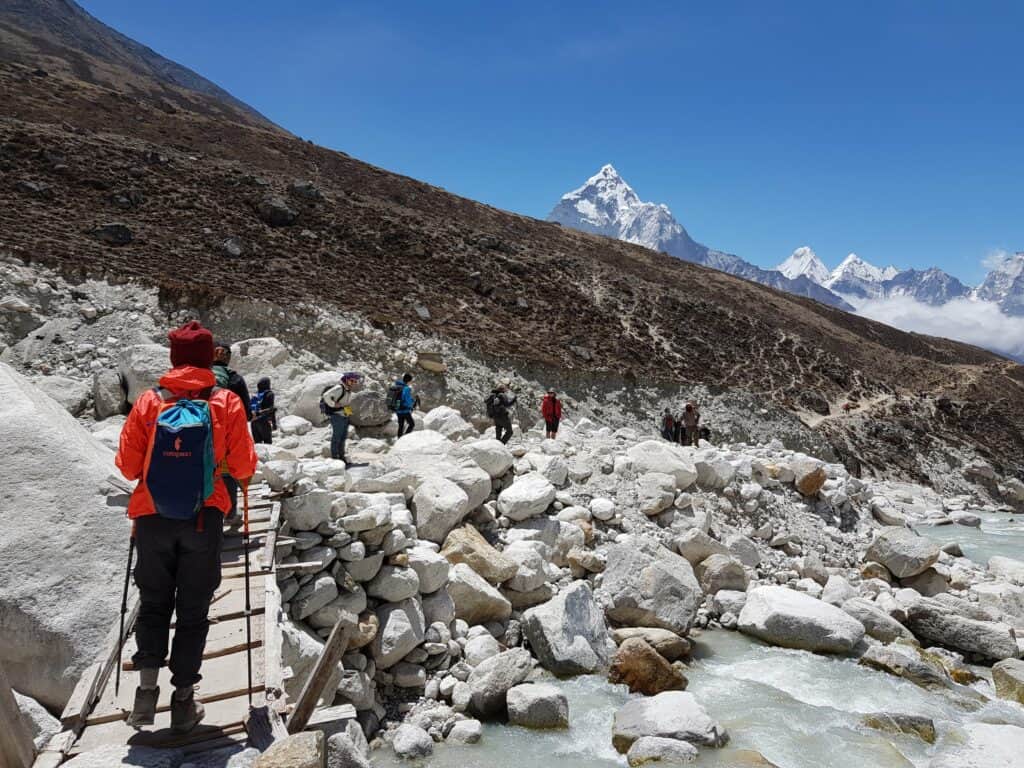
Packing Check-List
As a beginner, you need to be sure to pack enough and also not to over-pack. Although, the packing priorities can differ depending on the season, here are a few things you need to mark on your checklist.
Try to pack as lightly as possible without missing out on any essentials, for guidelines go through this ultimate packing list for Everest Base Camp Trek.
Clothes and footwear
- Sun hat, wool hat
- Windproof/waterproof jacket
- Lightweight down jacket
- T-shirts (long sleeves, half and thermal)
- Heavy down jacket for higher altitudes
- Several pair of gloves with different thickness levels
- Hiking pants, waterproof pants ad shorts
- Heavy trousers or pants for higher altitudes
- Underwears – bring several pairs
- Socks of different thicknesses (low-altitude to high altitude)
- Hiking boots with ankle support
- Sports shoes or lightweight trainer shoes
- Camp shoes or crocks to give your feet rest after a long day of trek
Personal Supplies
- Personal toothpaste and brush
- General toiletries and sanitizers
- Sunscreen with UV protection
- Sunglasses with UV protection
- Ear plugs and sleep masks for light sleepers
- Dust masks
- Biodegradable wet wipes and toilet paper
- Mirror, hair comb, and nail clippers
- Quick dry travel towels
- Water purification solution or tablets
- Any personal medications
- Snacks to enjoy along the way
- Sleeping bag
- Backpack or daypack
- Water bottle and thermos
Accessories
- Charger for your electronics and essentials
- Journal and reading materials
- Headlamp
- Binoculars
- Solar charger and extra pair of batteries for your accessories
- Portable charger
- Entertainment set
- And don’t forget a universal charger

FAQs Related to Everest Base Camp for Beginners
Can a beginner go to Everest Base Camp?
Yes, even a beginner can go to Everest Base Camp, you just need to prepare mentally, physically for the adventure and pack right.
Can a normal person climb Everest base camp?
Yes, a normal person can climb Everest Base Camp. As the difficulty level of the mt everest base camp trek is moderate to challenging, you do need prepare yourself physically.
Can you do Everest Base Camp with no training?
If you exercise regularly or play any kind of sports, you may not need to train for this high-altitude trek. Just make sure that you have a strength and endurance level that can handle 6-7 hours of walking on average. But, if you don’t consider yourself a reasonably fit person, immediately hit a gym class.
How a beginners practice for the hike to Everest Base Camp?
Beginners can start by doing 4-7 km of jogging every day or hiking in natural landscapes carrying a backpack or rucksack.
The strength training part and stair training method are also really helpful to easily traverse across diverse landscapes. Join gym and ask your instructors to help you prepare a preparation routine.
Is reaching Everest Base Camp difficult?
As there is significant altitude gain during the trek and the need for walking across several steep segments, it is not an easy feat. However, with the right training and preparation reaching Everest Base Camp isn’t a far-fetched dream.
Every year, thousands of trekkers either they are beginners or experienced, reaches EBC overcoming the Everest Base Camp Trek difficulty.
How fit do you need to be to get to Everest Base Camp?
You don’t need to be ripped or a heavyweight lifter for the Everest Base Camp trek, any average-build person with the required level of stamina and endurance can reach the base camp.
Can anyone go to Everest Base Camp?
Yes, anyone with the right level of mental and physical preparation can go to Everest Base Camp.
If you are 60-70+, just make sure to take it easy on yourself, in the past we have organized this trip for people over 70 and they have easily made it to Everest Base Camp.
As a beginner for EBC, can I customize the itinerary to make it easier for me?
Yes, as a beginner, it’s possible to customize your itinerary for trekking to Everest Base Camp (EBC). You can add additional customization days, take more time to reach the destination by walking a shorter distance every day.
You can reach out to us and we can customize an itinerary as per your requirements, fitness level, places you want to cover on the trail, etc.
Some Helpful Tips of Everest Base Camp Trek for Beginners
- Always follow the guidance of guide and porter, they have years of experience in the region
- Carry a basic medication kit and don’t forget to pack your personal medication
- Stay hydrated throughout the trekking experience, eating right and drinking plenty of water help to prevent altitude sickness
- Try to avoid smoking and drinking alcohol
- Enjoy the slow-paced adventure, it’s not a marathon, no need to rush and exert yourself.
- Although it is okay to take breaks, be mindful of the time schedules
- Always respect local culture, traditions, norms, and values
- Don’t go out on a self-exploration without consulting with the guide first.
- Stand on the mountainside not on the steep side while letting yaks and mules pass, they might push or kick you downhill
- Keep checking your oxygen saturation level and communicate with the guide in case of any inconvenience
- Dress properly and pack enough layers for different altitude clothing
- Carry energy bars and light snacks with you to stay energized.
- Read this do’s and don’ts in Nepal.
Summary
Our 14-day Everest Base Camp trek is the best fit for beginners as we have planned our itinerary carefully considering the safety of the trekkers.
Even if you are new to the high-altitude trekking adventure, the slow-paced walking and enough acclimatization days to get used to the high-altitude environment will make the adventure effortless.
Further, our experience guides and expedition leader with years of expertise in the field will make sure that you will complete the adventure safely with an immersive experience.
This 14-day package follows the most popular trekking route in the Khumbu region and doesn’t miss out on any highlights of the region.
So, even if you are a beginner, this will be the full exploration of the Everest region specially designed to make it easy for you to adapt to the high-altitude environment and just soak in the adventure without the need to worry about anything.
80% of trekkers who book with us are beginner-level trekkers and we have helped them all turn their dreams into reality.
Want more information? Send us your query, and our experts will get back to you within 24 hrs.
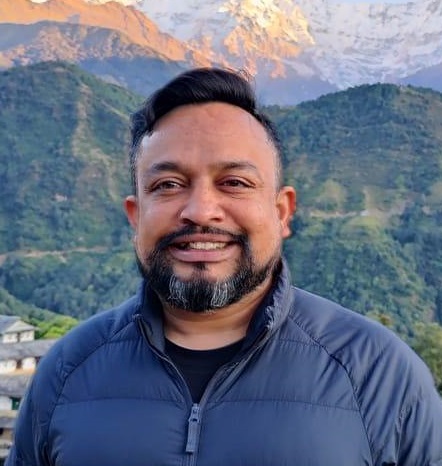
Raj is the co-founder of Mosaic Adventure who have immense knowledge of all the trail throughout Nepal. Working on the trekking industry for more than three decades Raj knows the country like back of his hands. If you need more information or help to plan any trips to Nepal, feel free to get in touch with Raj through his email [email protected] or whatsapp him on +9779851090836.

